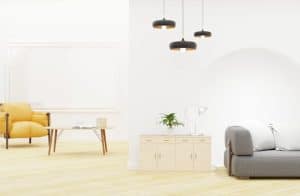Wellness Architecture: Homes That Boost Mental Health
Amidst the hustle and bustle of everyday life, more and more people are seeking ways to improve their mental well-being. It’s no secret that our surroundings have a significant impact on our emotions and overall mental health. This is where the concept of Wellness Architecture comes into play – designing homes that are aesthetically pleasing, practical, and most importantly, promote mental well-being. In this article, we dive into the world of Wellness Architecture and explore how it can transform our homes into sanctuaries for our minds and souls.
The Rise of Wellness Architecture
Wellness Architecture is not a new concept, but it has gained momentum in recent years as people become more aware of the impact of their environment on their mental health. According to the World Health Organization, mental health is “a state of well-being in which an individual realizes his or her own abilities, can cope with the normal stresses of life, can work productively, and is able to make a contribution to his or her community.”
Several factors contribute to our mental well-being, including our living spaces. The design of our homes can either enhance or disrupt our mental health. This is where wellness architecture steps in – it focuses on creating homes that support and promote mental well-being.
The Principles of Wellness Architecture
Wellness Architecture is based on three main principles – biophilia, sustainability, and functionality. Let’s take a closer look at each of these principles and how they contribute to creating homes that boost mental health.
1. Biophilia
Biophilia is the innate and emotional connection between humans and nature. Biophilic design principles aim to bring nature indoors by incorporating natural elements such as natural light, plants, and natural materials. Studies have shown that being connected to nature can reduce stress, enhance creativity, and improve overall well-being. Homes that incorporate biophilia principles provide a sense of calm and tranquility, promoting mental well-being.
2. Sustainability
Sustainability is another crucial aspect of Wellness Architecture. Green homes are designed to have a minimal negative impact on the environment while promoting a healthy lifestyle for its occupants. This includes using sustainable materials, energy-efficient appliances, and incorporating natural ventilation and lighting. By living in a sustainable home, individuals feel a sense of purpose and fulfillment, leading to improved mental health.
3. Functionality
Functionality is not just about having a practical layout. In Wellness Architecture, functionality refers to designing a home that meets the needs and preferences of its occupants. It takes into consideration the daily routines and activities of the individuals and creates a space that is both aesthetically pleasing and functional. By having a home that is tailored to their lifestyle, individuals feel a sense of control and comfort, thus promoting positive mental well-being.
Design Elements of a Wellness Home
Now that we have discussed the principles of Wellness Architecture, let’s take a peek into what design elements make a home a wellness home.
1. Natural Light
Natural light is a crucial element in wellness homes as it has a direct impact on our circadian rhythm, which regulates our sleep-wake cycle. Exposure to natural light helps our bodies produce serotonin, a neurotransmitter that promotes feelings of happiness and well-being. A home that allows ample natural light can significantly boost our mood and energy levels.
2. Outdoor Space
Having access to outdoor space is essential for our mental well-being. Whether it’s a balcony, terrace, or a backyard garden, having an area to connect with nature and get some fresh air is vital. Outdoor spaces also provide a sense of privacy and relaxation, allowing individuals to unwind and de-stress.
3. Colors and Materials
The colors and materials used in a home can have a significant impact on our mood and emotions. In a wellness home, natural, earthy colors and materials are preferred as they create a sense of warmth and tranquility. Colors such as greens, blues, and earthy tones have been shown to have a calming effect on our minds, while harsh and bold colors can evoke anxious feelings.
4. Mindful Spaces
Wellness Architecture also includes designing spaces that promote mindfulness and relaxation. This can be a meditation corner, a reading nook, or a yoga room. These spaces are essential for individuals to reset and reconnect with themselves, which can significantly improve their mental well-being.
The Benefits of Wellness Architecture
Now that we have explored the elements and principles of Wellness Architecture let’s discuss the benefits of designing homes that promote mental well-being.
1. Reduced Stress and Anxiety
Research has shown that our built environments have a significant impact on our stress levels. By incorporating elements of nature, sustainability, and functionality, Wellness Homes create a sense of calm, reducing stress and anxiety.
2. Improved Creativity and Productivity
Studies have found a direct correlation between our environment and our creativity and productivity levels. Natural light, the use of natural materials, and functional design can significantly improve an individual’s ability to focus and think creatively, leading to increased productivity.
3. Enhanced Physical Health
Wellness Architecture not only promotes mental well-being but also contributes to our physical health. Green homes are designed to improve indoor air quality, which can have a significant impact on respiratory health and reduce the severity of allergies.
4. Positive Outlook and Well-Being
Living in an environment that supports and promotes mental well-being ultimately leads to a more positive outlook and overall sense of well-being. By creating homes that cater to our basic needs, we can improve our mental health and live fulfilling lives.
In Conclusion
Wellness Architecture is more than just creating aesthetically pleasing homes. It takes into consideration our mental and emotional well-being and how our surroundings impact it. With the rise in mental health awareness, there is a growing demand for homes that prioritize our well-being. By incorporating the principles of biophilia, sustainability, and functionality, Wellness Architecture aims to transform our homes into sanctuaries for our minds and souls – a place where we can relax, recharge, and thrive.
So, the next time you think of remodeling or designing your home, consider adding elements of Wellness Architecture and give your mental health the care and attention it deserves.









